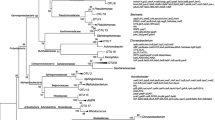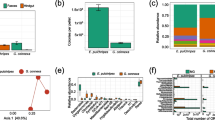Abstract
The insect larvae Protaetia brevitarsis seulensis have recently been researched as a nutritious food source and concentrated on their environmental impacts. Therefore, their gut microbiota has been studied to elucidate their effects and roles on the environment. Of the abundance of bacterial genus identified based on the 16S rRNA genes from isolates of the gut of insect larva Protaetia brevitarsis seulensis, six of the prominent genus were identified as Bacillus (40.2%), Cellulosimicrobium (33.5%), Microbacterium (2.8%), Streptomyces (3%), Krasilnikoviella (17.5%), and Isoptericola (3%) and their similarity of 16S rRNA blast changed from 99 to 100%. Cellulosimicrobium protaetiae BI34T showed strong denitrification and cellulose degradation activity. The newly complete genome sequence of BI34T and the genomes of five species was published in the genus Cellulosimicrobium with emphasis on the denitrification and secondary metabolite genes. In order to elucidate the relationship between the strain BI34T and the host insect larva, the whole-genome sequence was analyzed and compared with the genomes of five strains in the same genus, Cellulosimicrobium, loaded from GenBank. Our results revealed the composition of the gut microbiota of the insect larvae and analyzed the genomic data for the new strain to predict its characteristics and to understand the nitrogen metabolism pathway.
Graphical Abstract





Similar content being viewed by others
Data Availability
The datasets generated during and/or analyzed during the current study are available from the corresponding author upon reasonable request.
Abbreviations
- BGCs:
-
Biosynthetic gene clusters
- CDSs:
-
Protein coding genes
- COG:
-
Clusters of orthologous groups of proteins
- HGAP:
-
Hierarchical genome assembly process
- ncRNA:
-
Non-coding RNA
- NRP:
-
Non-ribosomal peptide
- SMRT:
-
Single-molecule real time
- RAST:
-
Rapid annotation subsystems technology
- rRNA:
-
Ribosomal RNA
- tRNA:
-
Transfer RNA
- T3PKS:
-
Type III polyketide synthase
References
Zumft, W. G., & Körner, H. (1997). Enzyme diversity and mosaic gene organization in denitrification. Antonie van Leeuwenhoek, 71, 43–58.
Yu, K., & Zhang, T. (2012). Metagenomic and metatranscriptomic analysis of microbial community structure and gene expression of activated sludge. PLoS ONE, 7, e38183.
Pajares, S., & Bohannan, B. J. M. (2016). Ecology of nitrogen fixing, nitrifying, and denitrifying microorganisms in tropical forest soils. Frontiers in Microbiology. https://doi.org/10.3389/fmicb.2016.01045
Le Han, H., Nguyen, T. T. H., Li, Z., Shin, N. R., & Kim, S. G. (2022). Cellulosimicrobium protaetiae sp. nov., isolated from the gut of the larva of Protaetia brevitarsis seulensis. International Journal of Systematic and Evolutionary Microbiology. https://doi.org/10.1099/ijsem.0.005296
Oh, M., Kim, J. H., Yoon, J. H., Schumann, P., & Kim, W. (2018). Cellulosimicrobium arenosum sp. nov., isolated from marine sediment sand. Current Microbiology, 75, 901–906.
Brown, J. M., Steigerwalt, A. G., Morey, R. E., Daneshvar, M. I., Romero, L. J., & McNeil, M. M. (2006). Characterization of clinical isolates previously identified as Oerskovia turbata: Proposal of Cellulosimicrobium funkei sp. nov. and emended description of the genus Cellulosimicrobium. International Journal of Systematic and Evolutionary Microbiology, 56, 801–804.
Gonzales Zamora, J. A., & Camps, N. (2018). Bacteremia caused by cellulosimicrobium in a bone marrow transplant patient: A case report and literature review. IDCases., 11, 64–66.
Kenzaka, T., Ishimoto, Y., & Tani, K. (2017). Draft genome sequence of multidrug-resistant Cellulosimicrobium sp. strain KWT-B, isolated from Feces of Hirundo rustica. Genome Announcements, 5, e00641-e1617.
Lee, J., Hwang, I. H., Kim, J. H., Kim, M.-A., Hwang, J. S., Kim, Y. H., & Na, M. (2017). Quinoxaline-, dopamine-, and amino acid-derived metabolites from the edible insect Protaetia brevitarsis seulensis. Archives of Pharmacal Research, 40, 1064–1070.
Yoon, C.-H., Jeon, S.-H., Ha, Y. J., Kim, S. W., Bang, W. Y., Bang, K. H., Gal, S. W., Kim, I.-S., & Cho, Y.-S. (2020). Functional chemical components in Protaetia brevitarsis larvae: impact of supplementary feeds. Korean Journal for Food Science of Animal Resources, 40, 461–473.
Sanschagrin, S., & Yergeau, E. (2014). Next-generation sequencing of 16S ribosomal RNA gene amplicons. Journal of Visualized Experiments. https://doi.org/10.3791/51709-v
Nikkhah, A., Van Haute, S., Jovanovic, V., Jung, H., Dewulf, J., Cirkovic Velickovic, T., & Ghnimi, S. (2021). Life cycle assessment of edible insects (Protaetia brevitarsis seulensis larvae) as a future protein and fat source. Scientific Reports, 11(1), 14030.
Geng, J., Sui, Z., Dou, W., Miao, Y., Wang, T., Wei, X., Chen, S., Zhang, Z., **ao, J., & Huang, D. (2022). 16S rRNA gene sequencing reveals specific gut microbes common to medicinal insects. Frontiers in Microbiology, 13, 892767.
Xuan, H., Gao, P., Du, B., Geng, L., Wang, K., Huang, K., Zhang, J., Huang, T., & Shu, C. (2022). Characterization of microorganisms from protaetia brevitarsis larva frass. Microorganisms, 10, 311.
Pheng, S., Han, H. L., Park, D. S., Chung, C. H., & Kim, S. G. (2020). Lactococcus kimchii sp. nov., a new lactic acid bacterium isolated from kimchi. International Journal of Systematic and Evolutionary Microbiology, 70, 505–510.
Yoon, S.-H., Ha, S.-M., Kwon, S., Lim, J., Kim, Y., Seo, H., & Chun, J. (2017). Introducing EzBioCloud: A taxonomically united database of 16S rRNA gene sequences and whole-genome assemblies. International Journal of Systematic and Evolutionary Microbiology, 67, 1613.
Thompson, J. D., Gibson, T. J., Plewniak, F., Jeanmougin, F., & Higgins, D. G. (1997). The CLUSTAL_X windows interface: Flexible strategies for multiple sequence alignment aided by quality analysis tools. Nucleic Acids Research, 25, 4876–4882.
Saitou, N., & Nei, M. (1987). The neighbor-joining method: A new method for reconstructing phylogenetic trees. Molecular Biology and Evolution, 4, 406–425.
Kumar, S., Stecher, G., & Tamura, K. (2016). MEGA7: Molecular evolutionary genetics analysis version 7.0 for bigger datasets. Molecular Biology and Evolution, 33, 1870–1874.
Le Han, H., Jiang, L., Thu Tran, T. N., Muhammad, N., Kim, S. G., Tran Pham, V. P., Ng, Y. J., Khoo, K. S., Chew, K. W., & Phuong Nguyen, T. D. (2022). Whole-genome analysis and secondary metabolites production of a new strain Brevibacillus halotolerans 7WMA2: A potential biocontrol agent against fungal pathogens. Chemosphere, 307, 136004.
Aziz, R. K., Bartels, D., Best, A. A., DeJongh, M., Disz, T., Edwards, R. A., Formsma, K., Gerdes, S., Glass, E. M., Kubal, M., Meyer, F., Olsen, G. J., Olson, R., Osterman, A. L., Overbeek, R. A., McNeil, L. K., Paarmann, D., Paczian, T., Parrello, B., & Zagnitko, O. (2008). The RAST server: Rapid annotations using subsystems technology. BMC Genomics, 9, 75.
Meier-Kolthoff, J. P., Auch, A. F., Klenk, H.-P., & Göker, M. (2013). Genome sequence-based species delimitation with confidence intervals and improved distance functions. BMC Bioinformatics, 14, 60.
Blin, K., Shaw, S., Steinke, K., Villebro, R., Ziemert, N., Lee, S. Y., Medema, M. H., & Weber, T. (2019). antiSMASH 5.0: Updates to the secondary metabolite genome mining pipeline. Nucleic Acids Research, 47, W81–W87.
Dou, T.-Y., Luan, H.-W., Ge, G.-B., Dong, M.-M., Zou, H.-F., He, Y.-Q., Cui, P., Wang, J.-Y., Hao, D.-C., Yang, S.-L., & Yang, L. (2015). Functional and structural properties of a novel cellulosome-like multienzyme complex: Efficient glycoside hydrolysis of water-insoluble 7-xylosyl-10-deacetylpaclitaxel. Science and Reports, 5, 13768.
Sharma, A., Gilbert, J. A., & Lal, R. (2016). (Meta)genomic insights into the pathogenome of Cellulosimicrobium cellulans. Science and Reports, 6, 25527.
Barth, K. R., Isabella, V. M., & Clark, V. L. (2009). Biochemical and genomic analysis of the denitrification pathway within the genus Neisseria. Microbiology (Reading), 155, 4093–4103.
Yang, T., Yang, Q., Shi, Y., **n, Y., Zhang, L., Gu, Z., & Shi, G. (2021). Insight into the denitrification mechanism of Bacillus subtilis JD-014 and its application potential in bioremediation of nitrogen wastewater. Process Biochemistry, 103, 78–86.
Sultanpuram, V. R., Mothe, T., Chintalapati, S., & Chintalapati, V. R. (2015). Cellulosimicrobium aquatile sp. nov., isolated from Panagal reservoir, Nalgonda, India. Antonie Leeuwenhoek., 108, 1357–1364.
Yoon, J. H., Kang, S. J., Schumann, P., & Oh, T. K. (2007). Cellulosimicrobium terreum sp. nov., isolated from soil. International Journal of Systematic and Evolutionary Microbiology, 57, 2493–2497.
Hamada, M., Shibata, C., Tamura, T., Nurkanto, A., Ratnakomala, S., Lisdiyanti, P., & Suzuki, K. (2016). Cellulosimicrobium marinum sp. nov., an actinobacterium isolated from sea sediment. Archives of Microbiology, 198, 439–444.
Qin, W., Fan, F., Zhu, Y., Huang, X., Ding, A., Liu, X., & Dou, J. (2018). Anaerobic biodegradation of benzo(a)pyrene by a novel Cellulosimicrobium cellulans CWS2 isolated from polycyclic aromatic hydrocarbon-contaminated soil. Brazilian Journal of Microbiology, 49, 258–268.
Acknowledgements
This research was supported by grants from the KRIBB Research Initiative in Korea and funded by University of Technology and Education - The University of Danang under project number T2022-06-06.
Author information
Authors and Affiliations
Contributions
HLH and TDPN conceived and designed the study. HLH, LTV, and PTQQ performed the research. HLH, SGK, and LMJ analyzed and validated data. KSK, KWC, and TNTT contributed to new methods and analytical tools. HLH and TDPN wrote the manuscript. KSK, SSC, and KWC reviewed and edited the manuscript. All authors read and approved the manuscript.
Corresponding author
Ethics declarations
Conflict of interest
There are no conflicts of interest.
Research Involving Human and Animal Rights
The manuscript does not contain experiments using animals. The manuscript does not contain human studies.
Additional information
Publisher's Note
Springer Nature remains neutral with regard to jurisdictional claims in published maps and institutional affiliations.
Genome information for the 16S rRNA, chromosome and plasmid are available under the GenBank/EMBL/DDBJ accession number MK966391, CP052757 and CP052758.
Rights and permissions
Springer Nature or its licensor (e.g. a society or other partner) holds exclusive rights to this article under a publishing agreement with the author(s) or other rightsholder(s); author self-archiving of the accepted manuscript version of this article is solely governed by the terms of such publishing agreement and applicable law.
About this article
Cite this article
Le Ho, H., Tran-Van, L., Quyen, P.T.Q. et al. Bioinformatic Approach to Investigate Larvae Gut Microbiota Cellulosimicrobium protaetiae via Whole-Genome Analysis. Mol Biotechnol (2024). https://doi.org/10.1007/s12033-023-00984-9
Received:
Accepted:
Published:
DOI: https://doi.org/10.1007/s12033-023-00984-9




